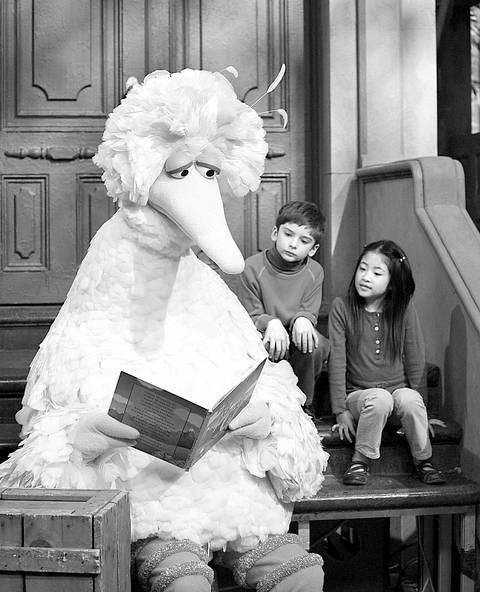Kermit Love best known for creating Big Bird’s costume
Published 5:00 am Wednesday, June 25, 2008

- Big Bird reads to Connor Scott and Tiffany Jiao during a taping of “Sesame Street” in April. Although Kermit Love collaborated with luminaries of dance like George Balanchine, Agnes de Mille, Robert Joffrey, Jerome Robbins and Twyla Tharp, it was the 8-foot-2, yellow-feathered Big Bird that brought him global attention.
Kermit Love, the costume designer for some of ballet’s most renowned choreographers whose greatest fame came as a creator, with Jim Henson, of the beloved “Sesame Street” characters Big Bird and Mr. Snuffleupagus, died Saturday in Poughkeepsie, N.Y. He was 91 and lived in Stanfordville, N.Y.
The cause was congestive heart failure, said Christopher Lyall, Love’s partner of 50 years.
Trending
Although Love collaborated with luminaries of dance like George Balanchine, Agnes de Mille, Robert Joffrey, Jerome Robbins and Twyla Tharp, it was the 8-foot-2, yellow-feathered Big Bird and his 7-foot, woolly mammoth-like friend Mr. Snuffleupagus — both perennially 6 years old — that brought him global attention.
“For Kermit, the costume was just the beginning,” said Kevin Clash, who is now senior puppet coordinator for “Sesame Street” and considers Love his mentor. “He taught how to create the character out of the costume.”
Caroll Spinney, 74, the man inside the bird since “Sesame Street” was first telecast in 1969, said, “We traveled the world doing shows for kids, sometimes with Big Bird conducting orchestras.”
In 1973, Spinney said, he and Love and a “big, hooped sack” containing Big Bird flew to Beijing to perform, a year after President Richard Nixon’s diplomatic breakthrough with Communist China. He said that Love “was very picky about how the bird was handled.”
Big Bird had his own seat, Spinney said, adding, “They gave us a half-priced ticket because he was only 6 years old.”
Characters come alive
Trending
Henson, the creator of “Sesame Street,” who died in 1990, did the original sketches of Big Bird. Love built the bird, with its manhole-sized orange foam feet. He added feathers (with some designed to fall off) to make the creature cuter. Inside, Spinney controlled Big Bird’s mouth with his hand and the eyes with a lever attached to his pinky finger. A television monitor inside the puppet allowed Spinney to see the set.
Love, who, with his Santa Claus-like beard played Willy the Hot Dog Man on the show, also helped design Oscar the Grouch and Cookie Monster; he insisted he was not the namesake of the famous frog. He created characters for 22 foreign versions of “Sesame Street.”
It was Love’s work fashioning costumes and masks for dance that brought him to the attention of Henson.
He had also worked in film and theater, including doing costumes for Broadway shows like “One Touch of Venus” in 1943 with music by Kurt Weill and lyrics by Ogden Nash; Mary Martin was the star.
A 1998 Dance magazine profile of Love said, “Regardless of the genre in which he works, each of his costumes is special because he seems to know a character’s personality and history and gives every detail a reason for being, historically as well as aesthetically.”
Love worked on de Mille’s “Rodeo” in 1942 and, two years later, on Robbins’ first ballet, “Fancy Free.”
Love worked with Balanchine for more than 40 years. In 1965, he built the 28-foot-high marionette for the Balanchine production of “Don Quixote.” A decade later, they collaborated on “L’Enfant et les Sortilèges” (“The Spellbound Child”), a one-act opera that tells the tale of a bratty boy who tears up his house and tortures his cat and squirrel, but is then taught lessons by objects that come to life. For the 1981 television production of the work, Love created settings and costumes, including dancing chairs, a clock that spins away from a wall and life-size owls, frogs and dragonflies that flutter about the boy.
For the Joffrey Ballet’s “Nutcracker,” Love dressed the mice in suits of armor.
How many “Nutcrackers” had he done? “Oh God, so many ‘Nutcrackers,’” he once said.
Growing up
Despite his assumed English (and sometimes French) accent, Kermit Ernest Hollingshead Love was born in Spring Lake, N.J., on Aug. 7, 1916. His father, Ernest Love, was a decorative plasterer. His mother, Alice, died when he was 3, and he was raised by a grandmother and a great-grandmother.
Young Kermit was first fascinated with Punch-and-Judy puppets at 7. “But what inspired me even more was shadow play,” he told New York magazine in 1985. “I can remember rigging a lantern and casting shadows on the wall.” Thrown by a horse at 12, he suffered serious damage to both legs. Bedridden for three years, he listened to radio dramas and drew pictures of what he imagined the characters looked like.
Love began making puppets for a federal Works Progress Administration theater in 1935 and soon after was designing costumes for Orson Welles’ Mercury Theater. Then he began working with Barbara Karinska, the costumer for the New York City Ballet.
Love is survived by Lyall.
Like a doting father, Love worried about Big Bird. In 1985, the two rode the Metroliner to Washington for the Easter Egg roll on the White House lawn. “The grass stained his feet,” Love complained to New York magazine. “He had to have his soles replaced.”








